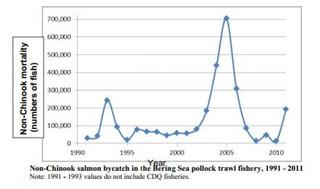North Pacific Council To Review Chum Bycatch Regs

Friday, February 24 2012
Last year, the Bering Sea pollock fleet took nearly 200,000 chum salmon as bycatch – more than they had taken in the past four years combined. Now fisheries regulators are working to find the best way to bring that number down.
The North Pacific Fishery Management Council hosted a teleconference on Friday to get input from rural Alaskans on their proposals. Subsistence fishermen like Nick Turner of Emmonak stressed that lower chum numbers mean less food and less money for their communities.
“I can’t express any deeper than I’m able to do right now that we just don’t have anywhere to turn as rural users of this resource, both for subsistence and commercial use,” said Turner. “Both of them are so tied into our way of life both in our culture and in our way to try to survive throughout the year.”
Right now, there’s a federal regulation in place that prohibits trawling in the Eastern Aleutians in August, when chum bycatch is at its peak. But more important is the “rolling hot spot program.” That uses real time monitoring to shut down the areas where chum bycatch is highest to the fleet’s worst offenders. Vessels that participate in that program are exempt from the August closures.
The North Pacific Council is trying to figure out whether it should stick with this system, or if it should go with one of two proposed alternatives. One option would have them put a hard cap on chum bycatch, much like the one in place for chinook salmon. That would close the fishery after too many salmon are taken. Right now, the council is considering a hard cap between 50,000 and 200,000.
The other plan mostly involves tweaks to the rules in place. It would change the boundaries and the timeframe of the summer chum closure area, and it could potentially remove the exemption carved out for participants in the rolling hot spot program.
Diana Stram is a coordinator with the North Pacific Council, and throughout the discussion she stressed that the big challenge was bringing down chum bycatch in the summer without increasing chinook bycatch in the fall -- and doing so in a way that didn’t shut down the commercial pollock fishery altogether.
“What is being balanced by the council are the different national standards that the council is responding to in terms of reducing bycatch, providing the opportunity for the fleet to catch pollock, as well as providing for the sustained participation of communities in the fisheries themselves,” said Stram.
A revised analysis of the alternatives will be released in March, and the North Pacific Council will review the options at a meeting later that month.



